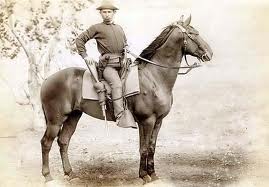
U.S cavarly
The Horse (Equus ferus caballus) is a hoofed mammal which was first domesticated by man around 4,000 BC. They have been used in warfare since the dawn of civilization until the 20th Century. The best Genarals, and most succsful armys in histore have used horses for Cavarly and/or transportation.
History of Horses in Combat[]
Evidence of horses being used for warfare dates back to Ancient Sumeria, the world's first civilization. Coupled with the development of the wheel, chariots soon became an important part of Sumerian warfare.
The first mounted warriors were either Scythian or Assyrian archers, although due to their posture (sitting far back on the horse) they were little more than mounted infantry as the horse could not move fast with the rider seated so precariously. Later, the Assyrians adopted the riding position still used today, giving birth to the first true cavalry units. The vikings normally had no real cavalry but have been Known to gather all the horses in the vicinity of their landings and use mounted infantry and occasinaly fight from horseback in small light troops. The samurai practice an art called yabusame wich was using the Yumi bow on horseback during times of war.
Most ancient armies used calvaries in some form. Both the Greeks and Romans used both light horse scouts and heavy calvary, although the bulk of their military consisted of infantry. Other armies, such as the Huns and Mongols consisted almost entirely of mounted warriors. In the Middle Ages, horses were used by knights during the onset of battle, although most ended up dismounting due to the terrain being poorly suited for such heavy calvary.
With the discovery of the New World, Spanish conquistadors armed with gunpowder weapons and mounted on horses were more than a match for the indigenous populations, resulting in the fall of the Aztec and Incan empires. However, Native Americans quickly learned how to use horses for hunting and warfare, particularly those from the Great Plains such as the Comanche and Cheyenne. Some tribes like the Apache used horse bone in their tools and weapons, including the tomahawk.
Calvary remained an important part of warfare after the advent of gunpowder. Russian Cossacks were used as elite cavalry during the Russian Empire, allowing Russia to rapidly conquer Siberia. During the French Revolution and Napoleonic Wars, calvary was used as shock troops, charging into the enemy ranks prior to an infantry assault, forcing the enemy to break ranks. In the American Civil War, the Confederacy, with its more experienced calvary, was able to dominate during the early years of the war, although the Union calvary would later be decisive in achieving victory. After the war Jessie James and his gang stole some the best bread american quarter horses they could get, that way nobody could cath them as they rided away from a crime scen.
It was not until the rise of automatic firearms in the early 20th Century that mounted warfare finally became obsolete after nearly 6,000 years of dominating the battlefield. Although conflicts such as the Russo-Japanese War proved cavalry lost its importance, traditionalist generals and officers fighting in WWI demanded to continue using cavalry only to end their charges in disastrous failure. The 44th Mongolian Cavalry led the last ancient-style Calvary charge in WWII, with the Axis forces facing no casualties and the Calvary division mostly destroyed.
They are still used by some police forces to help move in cities and charge at hostile crowds.
Advantages[]
The principle advantage of fighting from horseback is that it gave the rider far greater speed and maneuverability than a soldier on foot, making horses ideal for hit and run tactics. Furthermore, the added momentum of a charging horse made weapons such as spears and sabers more effective. Also horses can be trained to bite, kick, and headbutt enemy soldiers. Finally, mounted troops were able to travel much farther and faster than infantry (the Mongols were reported as being able to travel up to 100 miles a day).
Napoleon Bonaparte once said; 'Without cavalry, battles are without result.'
Disadvantages[]
Horses are naturally skittish and can be frightened by unfamiliar sights, sounds, and smells, meaning that horses used in combat had to be just as battle-hardened as the men who rode them. Also, as the horse is much larger than a person and tends to stick out on the battlefield, it makes a much more prominent target for a long-distance weapon, putting the horse in great danger. This was especially true with the advent of firearms, and during the American Civil War, horses often suffered disproportionately large numbers of casualties in relation to infantry.
Carrying tools and equipment on horseback was difficult as heavy loads can slow down a horse or might fall off. However there have been several solutions for such issues. The Mongols would put their meat under the saddle; every time the rider bounced, it would tenderize the meet. Carbine rifles frequently had a saddle-ring, which allowed them to rest from a saddle when not in use.
In Show[]
In the second season, Alexander the Great, Attila the Hun, the Comanche, and Mongol are the only warriors shown fighting from horseback. The Persians and Celts fought from war chariots pulled by horses. However, during the final battle in the Pirate vs. Knight episode, the Knight began the battle riding a horse, and during the Jesse James vs. Al Capone episode, the Colt Revolvers were tested from horseback, although it is never stated whether horses were factored into the simulation for Jesse James.
Warriors featured in the third season shown fighting from horseback, both during testing and in the simulation, were Napoleon Bonaparte, George Washington, Hannibal, Genghis Khan, Ivan the Terrible, Hernan Cortes, Crazy Horse and Pancho Villa.
Trivia[]
- Some people are unable to ride horses if they are too large or heavy. This was the case for Rollo the Walker and Winfield Scott.